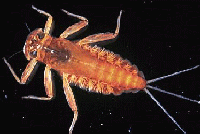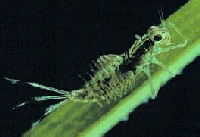The kind of mayflies and stoneflies that are seen in streams are nymphs, immature forms without wings. These insects only have an incomplete metamorphosis, unlike caddisflies and true flies. Whenever we say "mayfly" or "stonefly," we will be referring to the immature nymphs.
Mayflies and stoneflies look much
alike. You will have to examine them carefully with a magnifying glass to tell the difference, or even look at them through a microscope. As insects, both have six legs, of course. Both have elongated bodies, with long abdomens. Their similarities may have to do with their similar environments: both hug the bottom of fast streams, clinging to debris, rocks, and sediments with their tiny claws. Both must keep from being washed away (although some mayflies will let go and swim or drift sometimes), and both must breathe underwater.

|

|

|
| mayfly (Heptageniidae) | mayfly (Baetidae) | stonefly (Plecoptera) |
Mayflies and stoneflies differ in another way: while mayflies are generally herbivores--that is, they eat plant materials like fine detritus and algae, stoneflies are generally carnivorous, eating other animals like caddisflies, mayflies, and true flies. There are exceptions. A stonefly may eat detritus or plants when hungry, and a mayfly may eat other insects when it grows big enough to handle them.
Mayflies and stoneflies are usually found in mountain streams and other headwater streams, because of their need to breathe underwater. Although they have gills to let them do this, how much oxygen they will be able to absorb will depend on how much oxygen is in their water. Cold water carries more oxygen than warm water, and fast-moving water carries more oxygen than slow-moving water, like that in big, deep rivers, lakes, ponds, and marshes.
Mayflies and stoneflies live most of their lives as these immature nymphs underwater.
They may live a year, two years, or only a couple of weeks as nymphs, but this is a very long
time compared to what happens next. After molting one last time, they become winged adults
and fly into the air. They reproduce quickly, lay their eggs in the stream, and die.
The mayfly's story is especially fascinating. These delicate creatures with their shimmering
wings rise out of the water to join huge clouds of their own kind above the stream. They do
not eat: their sole purpose is to reproduce. Once they've mated and laid their eggs in the
water (some females actually crawl along under the water to lay their eggs),
they die and fall back into the stream, to be eaten by hungry trout. Although they
may last for 2 hours, or even 3 days in their winged form, some last less than 90 minutes before
dying. It is their brief, ephemeral existence as adults that has placed them in the order
"Ephemeroptera."
Adult stoneflies live longer, up to a few weeks, and live on riparian vegetation (vegetation
around the stream)or in the rocks by the side of the stream, which is why they are in the order
"Plecoptera," referring to the stones they live among. They will eat during their adult lives:
algae, buds, and young leaves.
Aquatic Macroinvertebrate Identification Key Online, completely automated key
Key to Aquatic Macroinvertebrates (all macroinvertebrate taxa, with excellent photos)
 Key to Macroinvertebrate Life (chart developed by Univ. of Wisconsin-Extension)
Key to Macroinvertebrate Life (chart developed by Univ. of Wisconsin-Extension)
Aquatic Invertebrate Identification (some beautiful photos and drawings)
![]() To learn more about mayflies and stoneflies, check out the reading list, where you will find some excellent references listed. (You will be able to order them from here, too).
To learn more about mayflies and stoneflies, check out the reading list, where you will find some excellent references listed. (You will be able to order them from here, too).
 Go back to Aquatic Invertebrates
Go back to Aquatic Invertebrates

| Site Search |
Incomplete metamorphosis is when an animal--an insect or a crustacean (like a crayfish)-- keeps close to the same body shape and form all the while it is growing up, like you and I do. The problem with this is that insects and crustaceans have exoskeletons (hard shells of a polysaccharide covering them), and exoskeletons don't grow! Instead, at a number of periods as they are growing up, they shed the whole exoskeleton. This is called ecdysis, or molting. While they are still soft and unprotected, they grow as fast as they can--and then they grow a new, bigger exoskeleton. Streams are littered with cast-off exoskeletons, which look exactly like the insect but are empty, and we call these exuviae (egg-zoo-via). We call the young of insects that are growing like this, nymphs. In streams, mayflies and stoneflies both go through incomplete metamorphosis. Each stage of nymph tends to be an identifiable size, and so we call them, depending on their size, "first instar," "second instar," and so on until they turn into imagoes. A typical aquatic insect may go through seven instars.
| Skaters | Planktonic | Divers | Swimmers |
|---|---|---|---|
| Skate on the surface of the water, and are more often found in calmer waters than streams. | Drift about in standing waters, like lakes and oceans, and usually cannot swim well enough to direct their movements. | "Row" with hind legs, dive to feed or when alarmed. Are found in lakes and other calm waters. Some beetles and true bugs are divers. | Can swim. They may cling to surfaces like rocks in between bouts of swimming. Many mayflies are swimmers. |
| Clingers | Sprawlers | Climbers | Burrowers |
| Attach themselves to surfaces using suckers, claws, and silk. Many mayflies are clingers, as well as a number of true flies and caddisflies. | Inhabit the surfaces of floating leaves or fine sediments, and must keep gills free of silt. Many mayflies are sprawlers, as well as dragonfly larvae. | Live on plants or other submerged vegetation, and can climb up and down. Dragonflies are an example. | Live in sediments by burrowing in, or may construct sand grain tubes that are buried part way, or may eat their way into sediments or tunnel into a plant stem, leaf, or root (miners). Midges and some mayflies fit in this group. |
Aquatic Insect Trophic Groups |
||||
| Shredders | Collectors | Scrapers | Piercers | Predators |
|---|---|---|---|---|
| Have strong, sharp mouthparts that allow them to shred and chew live plants or decomposing fragments. These are common among true flies, caddisflies, and stoneflies. | Gather the very finest suspended matter in the water. To do this, they often sieve the water through rows of tiny hairs. These sieves of hairs may be displayed in fans on their heads (blackfly larvae) or on their forelegs (some mayflies). Some caddisflies and midges spin nets, and catch their food in them as the water flows through. | Scrape the algae and diatoms off of surfaces of rocks and debris, using their mouthparts. Many mayflies, caddisflies, and true flies eat this way. | These herbivores pierce plant tissues or cells and suck the fluids out. Some caddisflies do this, as well as many true bugs, or Hemiptera. You may have watched a weevil sucking plant juices through a tubular mouthpiece--a weevil is a true bug. | Predators eat other living creatures. Some of these are engulfers; that is, they eat their prey whole or in parts. This is very common in stoneflies and dragonflies, as well as caddisflies. Others are piercers, which are like the herbivorous piercers except that they are eating live animal tissues. |